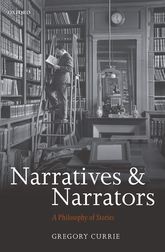
Editor-in-chief: Trevor Harris
Book Review Editor: Molly O'Brien Castro
![]()
Gregory Currie, Narratives & Narrators: A Philosophy of Stories (Oxford: Oxford University Press, 2010). £40, 243 pages, ISBN 978-0-19-928260-9 (also available in paperback and eBook)—John Pier, Université François Rabelais, Tours
“Narratives are the product of agency; they are the means by which someone communicates a story to someone else. Narratives represent their stories and do so in a special way characteristic of communication between agents.” [1] So begins Narratives & Narrators by Gregory Currie, an analytical philosopher well known for his work in esthetics and in the theory of fiction (The Nature of Fiction, 1990; Image and Mind: Film, Philosophy, and Cognitive Science, 1995; Arts and Minds, 2004). The definition clearly invites comparison with a wide range of other definitions. To mention but a very few: “a narrative is a long sentence, just as every constative sentence is in a way the rough outline of a short narrative” (Barthes); “a linguistic production undertaking to tell one or several events […] I walk, Pierre has come are for me minimal forms of narrative” (Genette); “The representation (as product and process, object and act, structure and structuration) of one or more real or fictive events communicated by one, two or several (more or less overt) narrators to one, two, or several (more or less overt) narratees” (Prince); “Narrative is the representation of events, consisting of story and narrative discourse, story is an event or sequence of events (the action), and narrative discourse is those events as represented” (Abbott); “somebody telling somebody else on some occasion and for some purpose(s) that something happened” (Phelan).
On the face of it, Currie’s definition of narrative would appear to be in line with Phelan’s, a rhetorical theory of narrative with credentials dating back to Booth’s The Rhetoric of Fiction (1961). This is not the case, however, for in a series of principles drawn from pragmatics, relevance theory, Gricean conversational implicatures, logic, the theory of action, communication theory and the cognitive sciences, all crafted to the particularities of narrative, the author systematically specifies the terms of his definition and stakes out their implications for narrative study. The first postulate is that stories, whether fictional or factual, are intentional-communicative artifacts: “intentionally fashioned devices of representation that work by manifesting the communicative intentions of their makers.” [xvii] Like stones axes, stories are made to perform a function and must thus be used/understood in accordance with the intentions of the agents who fashioned them. Unlike (pre-historical) implements, however, stories are representational artifacts: being the products of their makers, they represent events and characters, but this occurs in such a way that characters “are entities that supervene on the making of artifacts rather than being artifacts themselves.” [3] The consequence of this statement (buttressed by others at various points throughout the book) is significant, for among other things it says that while stories can be told about lives, lives themselves are not narratives: “no life is a narrative since no life is a representational artefact.[…] at best, one’s life and one’s narrative of the life overlap, with lots of the life missing from the narrative and, no doubt, plenty of mistakes in the narrative about the life.” [24] (cf. chapter 10: “Narrative and Character” and chapter 11: “Character Scepticism”). This position (also entertained by Galen Strawson in a famous essay entitled “On Narrativity” [2004]) is but one of Currie’s arguments that runs counter to a widely held thesis in contemporary narrative theory which is embraced, among others, by Ricœur, by rhetorical narratology, by proponents of “narrative psychology” and by various currents of cognitive approaches to narrative. The effect of such argumentation, whether one rallies to it or not, is salutary, for it provides grounds for re-examining unspoken articles of faith that too often go unchallenged.
Among the other dimensions of narrative addressed by Currie is “the duality of storytelling”: “the story told – the characters and events – and the vehicle [or mode] of telling, the narrative.” [vi] This reflects the fundamental and familiar distinction between story and discourse – the “content” and “expression” of narrative. The unity of narratives, Currie contends, is partly a matter of causal unity or “causal connectedness” such that, in a first approximation, narratives are characterized “by what they represent: sustained temporal-causal relations between particulars, especially agents.” [27] Causation, however, is a notion with a long and complex history that covers a wide variety of phenomena which are often misapprehended by literary theoreticians. Misunderstanding occurs when, for example, causation is equated with expressions such as “chronological-logical structure” to describe one of the fundamental differentiating features of narrative. Among the problems encountered with such a conception is that causation includes microphysical chains of events from whose perspective the macroscopic, mental and social events forming the stuff of narrative are regarded as “mere illusions of causal connectedness.” [28] In practice, no precise philosophical theory of cause can satisfactorily account for what occurs in a story. This is the case of a story (related by Aristotle) in which Mitys was murdered and the murderer of Mitys was then killed by a falling statue of Mitys. A sense either of justice or of pure coincidence might be perceived here, but strictly causal elements (e.g., that an individual was killed by a falling object) are not core issues in such a series of incidents. What matters in narrative content, says Currie, is relations of dependency. Although dependency frequently integrates or presupposes elements of causation, “causal relatedness [is not] the heart and soul of narrative.” [38], for indeed there are cases in which the absence of causal relations between events is the very point of the story.
Narratology has provided a concept which is quite specific to the question of dependency in narrative, known as narrativity. Now, narrativity involves a number of features, but the one Currie is most interested in, and which forms one of the leitmotifs of the book, is what Gerald Prince called “narrativeness,” a gradational principle by which a parable will be perceived as more narrative than historical annals but less narrative than an adventure story. Much less narrative (at least in any conventional sense) is the following example in which causal information and indeed any form of dependency between events is fully evacuated: “Mitys was murdered; later a statue of someone fell on someone else; neither of them had anything at all to do with Mitys.” [38] As these considerations show, one of the points of interest of Narratives & Narrators is to bring logic and a variety of other philosophical and disciplinary concepts to bear on questions that are central to narrative theory and to draw the consequent conclusions, even where this may run counter to positions held by the community of narrative theoreticians.
Like many of the terms chosen by Currie, the duality of storytelling, i.e. the story told and the mode of its telling, does not correspond entirely to what is ordinarily understood by story (what?) and discourse (how?) or by fabula (the action itself) and sjuzhet (the presentation of the story by the text). The duality at issue is a duality of perspective: internal (the story-content features of unity, time, specificity, causation) and external (the authorial attitude to story content, a framework through which a point of view is expressed in a process of guided attention; cf. chapter 5: “Character-focused Narration”). For Currie, it is impossible to understand narrative by dissociating the two perspectives: an author may choose to tell the protagonist’s life story, in which case he will incorporate causal-temporal relations into the discourse, or he may want to emphasize the protagonist’s character traits, thus dispensing with any detailed account of the sequence of actions. The salient possibilities for what will be represented in one case or another – the “option [at a given stage of a narrative] for how things might turn out later” [54] according to the criteria of possibility, probability and evidence – arise out of this duality of perspective. In either case, the degree of narrativity will be affected, confirming that the narrativity of a representation cannot be determined exclusively on the basis of internalist criteria or externalist criteria, but through the combination of internal story features and external expressive features.
Yet other consequences derive from the conception of narrative as an intentional-communicative artifact, the product of its maker. The one that is likely to be most controversial among narrative theorists is that Currie does not distinguish between authors and narrators. The argument is indissociable from the internal/external perspectives of storytelling. To illustrate: Dr. Watson of the Sherlock Holmes stories is present in the stories and does not identify with the Conan Doyle, the author. But he is not a real narrator, any more than he is a real doctor or Holmes a real detective: within the context of the story, Watson is the author. Consequently, “we have grounds for distinguishing between someone being an author/narrator and it being part of the story [the case] that someone is an author/narrator. Bearing in mind an earlier distinction, we can say that Watson is the internal author/narrator and Doyle the external author/narrator.” [67]
It results from this reasoning that internal narrators are neither a necessity for narrative nor the default option, even though from the external perspective there is always a narrator: the (real) author. However, the economy of the system is such that more complex dimensions of the author/narrator can be taken into account, including instances where a voice from without the fiction is not truly the voice of the author. Such is the case when the personality of the author that emerges from the narrative deviates from the known facts of the author in real life (implied author), or when the author deliberately adopts a voice which is not his own for the purpose of irony (cf. chapter 8: “Irony: A Pretended Point of View”) or impersonation (second author). In both cases, readers are called on to imagine a new author or a new authorial persona. Volumes can be (and indeed have been) written on these issues. What is interesting about Currie’s proposal, and is indeed worthy of further debate, is that it demotes the rarely questioned divide between author and narrator by claiming that narrators are in fact authors, the relevant distinction being internal or external author/narrators, thereby favoring a division between author and implied/second author.
Numerous other questions of narrative theory to which Narratives & Narrators brings the insights of analytical philosophy and related disciplines exceed the limits of a short review. The positions Currie stakes out and argues with admirable clarity reveal a discerning eye for the state of current narrative theory, while at the same time steering clear of the dual risks of uncritically embracing shared dogmas and commonplaces and of engaging in open-ended and sometimes sterile controversies. On this score, it is notable that the book proposes not yet a another theory of narrative but, as its subtitle suggests, subtly echoing Poe’s “A Philosophy of Composition,” a philosophy of stories.
© 2013 John Pier & GRAAT On-Line



Senior
sub-editor: Hélène Tison
lntison@yahoo.fr
Webmaster: Georges-Claude Guilbert
